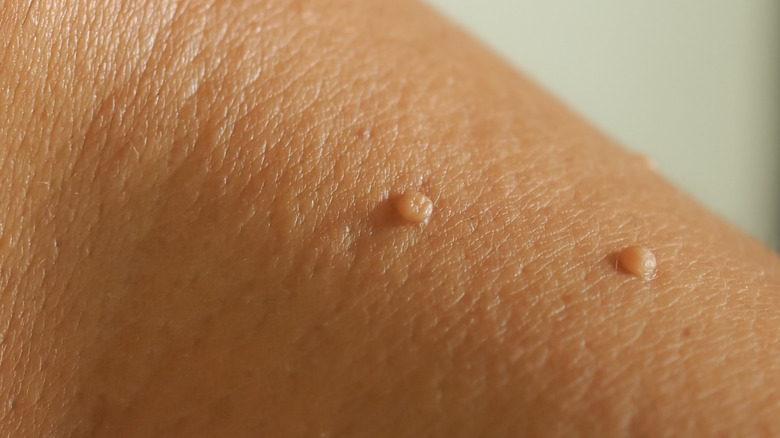Why You Should Think Twice Before Removing A Skin Tag At Home
Skin tags, otherwise known as acrochordons, are small, fleshy protrusions on the skin's surface (via Water's Edge Dermatology). Usually, between one to five millimeters in size, experts at the Cleveland Clinic say that 50% of adults are estimated to develop one or more skin tags during the course of their life. While they're not considered dangerous, some people opt for the removal of these noncancerous growths for aesthetic reasons.
Assistant professor of dermatology at Johns Hopkins, Dr. Sara Lamb, explains via the American Association of Retired Persons (AARP) that skin tags are often a product of friction and therefore appear in places on the body prone to rubbing, such as under the breasts, in the armpits or thigh creases, as well as on the neck. Experts at the Dermatology Center of Northwest Houston say that skin tags can also develop on the eyelids or around the groin. Unlike picking off a scab or pimple, skin tags are firmly rooted in place by a tiny stem at the base (per Cleveland Clinic). Therefore, if you're considering at-home removal of a skin tag, there are risks to be aware of before doing so.
The risks of improper skin tag removal
Attempting to remove a skin tag through the use of scissors or nail clippers can increase one's risk for irritation and infection, cautions experts at Water's Edge Dermatology. Furthermore, although they may be small in size, skin tags can produce quite a bit of blood. In the event of excessive bleeding, emergency care may be required. If tying off a skin tag with a piece of string sounds like a more appealing alternative, you may want to think again. Doing so is a much longer process, and experts say you may endure a rotting smell as the skin tag slowly decays. All in all, forced removal of a skin tag is generally quite painful.
Not only that, but what you're trying to remove may not be a skin tag at all. Without consultation from a dermatologist, you may unknowingly be removing a wart, mole, or skin cancer, according to experts at the Cleveland Clinic. Improper removal of a skin cancer growth can cause any leftover cancerous cells to spread, as per Water's Edge Dermatology.
Rather, it's best to leave skin tag removal to the professionals who can remove it through surgical means, cryotherapy, or cauterization. When removed properly by a dermatologist, a skin tag is not likely to grow back (via AARP). However, if you are prone to skin tags, more may develop over time on the same parts of the body.


